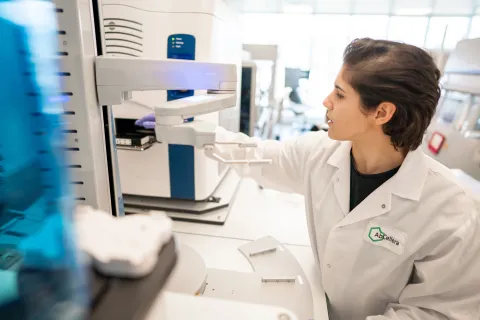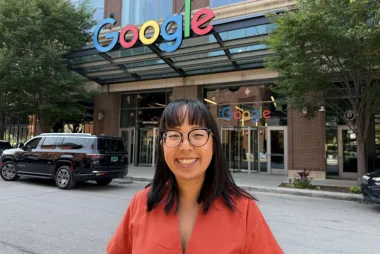From a hands-on start in Mechanical Engineering Technology at Camosun College to leading robotics projects at UBC and landing jobs through unexpected networking moments, Amy Hashemi’s journey highlights the power of adaptability, persistence, and authentic connections.

- Employer: AbCellera
- Degree: Bachelor of Applied Science
- Program:
- Campus: Vancouver
From Music Dreams to Mechanical Engineering
Amy’s path to UBC Engineering was anything but traditional. In high school, she excelled in AP physics and chemistry while balancing athletics, particularly hockey. Though she dreamed of being a musician, a school advisor encouraged her to consider engineering due to her problem-solving strengths.
She began her studies at Camosun College, diving into hands-on learning from day one. “The first week there, we were in the machine shop learning how to use a lathe and a mill,” she recalls. Seeking further education, she entered Camosun’s bridge program, which allowed her to transition directly into UBC’s third-year Mechanical Engineering program.
Adjusting to UBC
Despite her strong technical background, Amy found the transition from Camosun to UBC to be a major adjustment, needing to shift how she learned. She found UBC’s academic structure to be far more conceptual and demanding. The shift to larger lecture halls, high-pressure labs, more theoretical coursework, and fewer resources for students proved to be challenging. But she credits her practical experience from Camsoun with providing her valuable context fo the theoretical coursework.
Beyond classes, she joined UBC Thunderbots, a student team designing autonomous soccer-playing robots. She describes the experience as "pivotal", offering practical exposure to engineering challenges outside the classroom. Balancing Thunderbots, co-op, and coursework was demanding— “school is all you do,” she admits—but worth it.
Turning Conversations into Co-op Opportunities
Amy landed her first co-op at Neptune Bulk Terminals in North Vancouver thanks to a lighthearted conversation at a networking event.
The recruiter mentioned juggling, so I said I could juggle too. Next thing I knew, I was juggling for him. That spontaneous moment helped me stand out and led to an opportunity. Being able to change how you interact with someone based on how they interact with you is an incredibly useful skill.
While the experience gave her valuable exposure to large-scale engineering projects, it also helped her realize that Maintenance Engineering wasn’t the right fit.
When Tesla held a recruitment event at UBC, Amy joined hundreds other students in an auditorium vying for a coveted internship with the company. She didn’t think she had a chance, but her involvement with UBC’s Thunderbots team gave her an unexpected edge. Tesla actively sought out student team members for their hands-on engineering experience. As the mechanical team lead, Amy got the opportunity to attend a private networking event and connected with Tesla representatives. That conversation led to an interview—and ultimately, the job as a Software Engineer.
Amy’s ability to connect with people, adapt to different situations, and build relationships was key to getting her jobs.
The Skills that Matter Most
Amy emphasizes that success in engineering goes beyond technical skills—it’s about knowing how to connect with people. Confidence, adaptability, and reading a room are key. Rather than memorizing scripted questions at networking events, she suggests starting conversations naturally, like complimenting someone’s shoes or asking about their experiences. Building rapport quickly is an invaluable skill, not just for job searching but for navigating the workplace and life in general.
On the technical side, she highlighted resourcefulness and persistence. Engineering problems rarely have easy solutions, so students must be persistent and willing to test different approaches, but also knowing when to seek help. Success isn’t about knowing everything upfront, but about efficiently finding the right answers and leveraging others’ expertise.
An Unexpected Journey to Biotech
After graduating, Amy worked as a Development Engineer at Photon Control, designing temperature sensors for the semiconductor industry. Though she wasn’t actively job hunting, a chance encounter in a hockey locker room introduced her to an AbCellera engineer, and months later, another hockey teammate mentioned working there too. That serendipitous connection led to an informal LinkedIn chat, an application, and ultimately, her current role.
Now, as part of AbCellera’s Lab Automation team, Amy programs robots, optimizes workflows, and collaborates across disciplines to streamline scientific processes. Though she never expected to work in biotech, she’s embraced the industry’s cutting-edge technology and problem-solving challenges.
Looking back, she credits networking for most of the jobs that she’s landed.
Final Advice: Try, Fail, and Find your Passion
Amy’s biggest piece of advice for students is to invest in themselves—try new things, embrace failure, and build resilience. “The first step in getting good at something is to be really bad at it,” she says.
Beyond career success, she encourages students to find what excites them, even if it’s unrelated to their profession. For her, that’s music and hockey. People can tell when you care about something, and that authenticity is what truly sets you apart.

